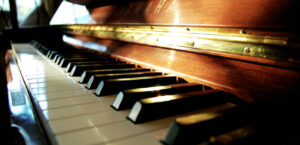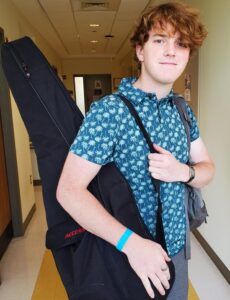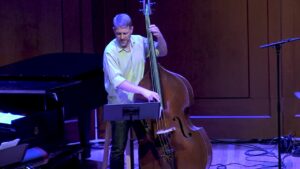The UNC Summer Jazz Workshop ran for five days this June and invited students, the community, and high schoolers to come to learn about jazz in all-day sessions, culminating in faculty and students’ performances. These are some of my takeaways as a newcomer to all things musical.
- There are a lot of men in jazz. (like a lot of them)
On my first day of UNC’s summer Jazz Workshop I walked up to Kenan Music Building expecting a similar makeup of my other summer classes – UNC has a female population of nearly 60% and it is usually evident in the classroom, but I was fairly surprised to see a line of mostly men signing in. My journalism track classes were gender-wise more even, and I was glad to find company there, but when I went to observe combo groups I noticed the gender gap and it didn’t make a lot of sense to me: a female majority school holds a one-week Jazz Summer Intensive full of extremely inviting an engaging professors willing to teach students of all abilities – seems like a great deal for anyone even vaguely interested in jazz or music so I had to ask myself why aren’t more women participating in this? Doing some digging online I found that an article in NPR reported that not only do women still comprise a minuscule amount of personnel on jazz albums, but they also find that even in categories where numbers have improved “critical recognition is disproportionately limited to a small group of exceptional women” which I suppose is a working definition of tokenism. The point here is that while I, a woman, had a stellar experience and recommend it to any and all, it seems like some systemic inequities within the genre need to be addressed so that other women can enjoy the experience as I did.
2. Jazz can be an accessible art form if you let it be
A major misconception I had of jazz, and I suspect that others may have, is that jazz is one of those art forms in the echelon of operas, classic poetry, and arthouse movies that is simply too highbrow for the average joe. I personally was a little intimidated to come into this workshop having only ever listened to Ella Fitzgerald and maybe a Louis Armstrong song or two in a movie soundtrack and figured that I may just not ‘get it’ when I got here and started listening. It turns out that is not true. In the jazz history course I took, I learned that jazz is not a monolith, and the more avant-garde and smooth jazz styles that I had associated specifically with jazz are only parts of jazz music. Learning the timeline of the popularity of jazz was helpful to me because jazz like big band and swing were some of the most popular forms because they were very accessible to the public and certain other forms that were considered more artistic were not necessarily for dancing and not nearly as popular, which makes me feel better about having my preferences. A major takeaway is that I do like jazz, I like fusion jazz, swing, other, more danceable types, and the association of jazz with only the most highbrow purely improvisational styles is a misconception I am glad to have corrected.
3. Music has languages
One of the first things we learn in jazz history and music skills class is that jazz is a language / has its own language. I grew up in a K-12 private school where a few of my friends did classical training of violin, cello, flute, piano, etc and performed in orchestras outside of school. Watching these made me think music was a very stiff thing to learn and practice, and the precision with which my musical friends learned to play seemed uptight. The language of this classical music seemed very precise, refined, and geared toward mastery. Listening to the professors and daily guest lecturers and performers in the summer jazz camp, it seemed like a lot of that is thrown out the window. While classical training seems structured, jazz seems to be more about a feel than technical mastery. In addition, no music teacher I have ever met talks like the jazz professors. The teachers seem to gesture and hum their way through explanations in a language of their own and somehow the class just gets it and goes along. I have to say I do not understand most of it but I did enjoy watching it. There is an entertainment value there and a lack of formality that makes learning an inviting thing.
4. It is illegal to play “Stairway to Heaven” in a guitar store
I am pretty sure this is a joke, but for some reason, all the musicians know it. Maybe it seems unimportant but I think it points out an example of community that the musicians participating in this workshop share and seems to me to be a part of insider non-formal knowledge of music that I have been trying to get in on. To be transparent, my secret reason for joining this workshop was to find somebody who knows somebody to teach me, a disabled kid, guitar. It seemed to be a good way to do this would be to break into the music circles here and get some of the music knowledge that I lack – which is all of it. The Stairway to Heaven ‘ban’ isn’t the most important thing I learned but it did confirm my experience that as a disabled person, it is kind of hard to get into music, to get lessons, and gain that knowledge. However, I know that even though I haven’t yet achieved my super-secret summer jazz workshop goal of hoodwinking somebody into teaching guitar to me, I have figured out that the UNC music department is a welcoming bunch, which is an encouraging start.



